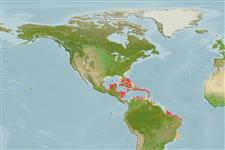Environment: milieu / climate zone / depth range / distribution range
Ecologie
marien demersaal. Tropical
Western Atlantic: southern Florida (USA), Bahamas, and northeastern Gulf of Mexico to Greater Antilles and Central America (Ref. 7251). Also western Caribbean, Antilles, Yucatan (Mexico) (Ref. 26938).
Grootte / Gewicht / Leeftijd
Maturity: Lm ? range ? - ? cm
Max length : 7.5 cm TL mannelijk / geslacht onbekend; (Ref. 7251)
Dorsale zachte stralen (totaal) : 7 - 37; Anale stekels: 2. Common amongst Labrisomids: small, often elongate fishes; largest species about 20 cm standard length, most under 10 cm standard length. Head usually with cirri or fleshy flaps on anterior nostrils, eyes, and laterally on nape; gill membranes continuous with each other across posteroventral surface of head. Each jaw with an outer row of relatively large, canine-like or incisor-like teeth, often with patches of smaller teeth behind; teeth usually also present on vomer and often on palatines (roof of mouth). Dorsal and anal fins long, frequently highest anteriorly; dorsal-fin spines often flexible, outnumbering segmented dorsal-fin soft rays; 2 usually flexible spines in anal fin; pelvic fins inserted anterior to pectoral-fin bases, with 1 spine not visible externally; all fin rays, including those of caudal, unbranched (simple). Cycloid (smooth to touch) scales present at least posteriorly on body. Body coloration: varying from drab to brilliant hues; usually with irregular vertical bands, spots, or marbled pattern. Species distinguished by: length of shortest pelvic-fin ray half, or less than half, length of longest ray; pectoral-fin rays usually 14; maxillary bone exposed posteriorly; patches of small teeth behind outer row of large teeth in at least upper jaw; palatine teeth present, some distinctly larger than those on vomer and some equal in size; two or more cirri on each side of nape just anterior to dorsal-fin origin; pelvic-fin soft rays 3 (innermost ray may be reduced in length and folded over middle ray); scales in lateral-line series 40 to 69 (some scales in posterior portion of lateral line may lack sensory tubes, but are included in count); lateral-line tubes or canals present at least anteriorly on body; dorsal fin consisting of spines and 7 to 37 segmented rays (Ref.52855).
Occurs from rocky and rubble shores with algal mats to reefs and seagrass beds.
Levenscyclus en paargedrag
Maturiteit | Voortplanting | Paaien | Eieren | Fecunditeit | Larven
Robins, C.R. and G.C. Ray, 1986. A field guide to Atlantic coast fishes of North America. Houghton Mifflin Company, Boston, U.S.A. 354 p. (Ref. 7251)
Status op de Rode Lijst van het IUCN (Ref. 130435: Version 2024-2)
Gevaar voor de mens
Harmless
Gebruik door de mens
Visserij: commercieel; Aquarium: Commercieel
Tools
Speciale rapporten
Download XML
Internetbronnen
Estimates based on models
Preferred temperature (Ref.
123201): 26.4 - 28.2, mean 27.5 °C (based on 577 cells).
Fylogenetische diversiteitsindex (Ref.
82804): PD
50 = 0.5078 [Uniqueness, from 0.5 = low to 2.0 = high].
Bayesian length-weight: a=0.00537 (0.00222 - 0.01301), b=3.08 (2.87 - 3.29), in cm total length, based on LWR estimates for this (Sub)family-body shape (Ref.
93245).
Trofisch niveau (Ref.
69278): 3.7 ±0.6 se; based on size and trophs of closest relatives
Fishing Vulnerability (Ref.
59153): Low vulnerability (10 of 100).
